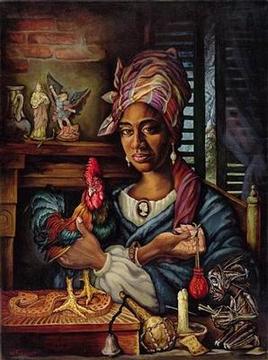
Among the sites associated with New Orleans voodoo is the tomb of its greatest figure, Marie Laveau. For several decades this "voodoo queen" held New Orleans spellbound-figuratively, of course, but some would say literally, as legends of her occult powers continue to captivate. She staged ceremonies in which participants became possessed by loas (voodoo spirits) and danced naked around bonfires; she dispensed charms and potions called gris-gris, even saving several condemned men from the gallows; and she told fortunes, healed the sick, and herself remained perpetually youthful while living for more than a century-or so it is said (Hauck 1996; Tallant 1946).
Marie Laveau
A "free person of color," Marie Laveau was the illegitimate daughter of a rich Creole plantation owner, Charles Laveaux, and his mistress Marguerite (who was reportedly half black, half Indian). Marie was probably born about 1794. At the age of twenty-five she married a carpenter named Jacques Paris, also a free person of color, who soon went missing and was presumed dead. Following the custom of the time, she began calling herself the "Widow Paris." Soon, she entered a common-law marriage with one Christophe de Glapion with whom she would have fifteen children, but as late as 1850 a newspaper still referred to her as "Marie Laveaux, otherwise Widow Paris" (Tallant 1946, 67).
The Widow Paris learned her craft from a "voodoo doctor" known variously as Doctor John, John Bayou, and other appellations, and by 1830 she was one of several New Orleans voodoo queens. She soon came to dominance, taking charge of the rituals held at Congo Square and selling gris-gris throughout the social strata. Marie worked as a hairdresser, which took her into the homes of the affluent, and she reportedly developed a network of informants. According to Tallant (1946, 64), "No event in any household in New Orleans was a secret from Marie Laveau." She parlayed her knowledge into a position of considerable influence, as she told fortunes, gave advice on love, and prepared custom gris-gris for anyone needing to effect a cure, charm, or hex.
If she did not actually save anyone from a sentence of death, she allowed such stories to flourish. "The Widow Paris thrived on publicity," observes Tallant (1946, 58). "Legend after legend spread about her and she seems to have enjoyed them all." The legend of her perpetual youth is easily explained: She had a look-alike daughter, Marie Laveau II, who followed in her footsteps. About 1875 the original Marie, bereft of her youth and memory, became confined to her home on Rue St. Ann and did not leave until claimed by death some six years later. "It was then," reports Tallant (1946, 73), "that the strangest part of the entire Laveau mystery became most noticeable. For Marie Laveau still walked the streets of New Orleans, a new Marie Laveau, who also lived in the St. Ann Street Cottage."
read more about voodoo secrets at http://theunexplainedmysteries.com/voodoo-secrets.html

No comments:
Post a Comment